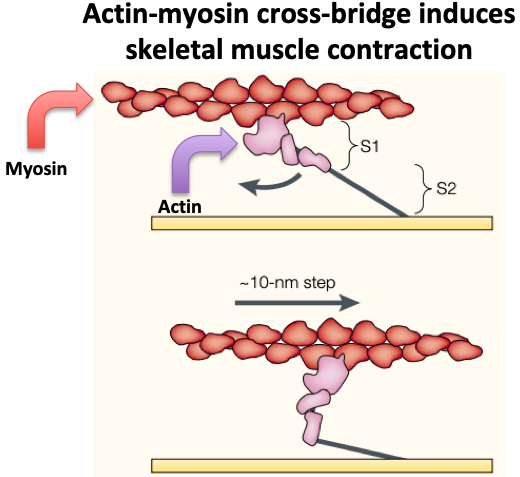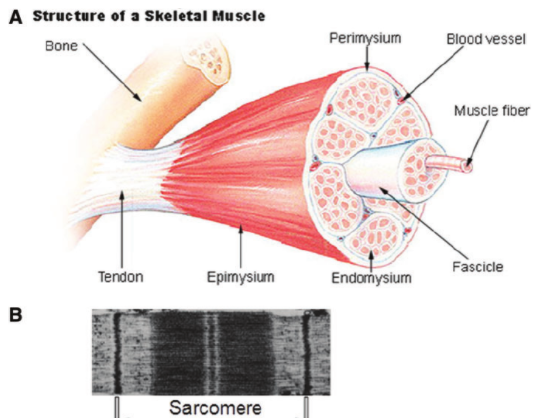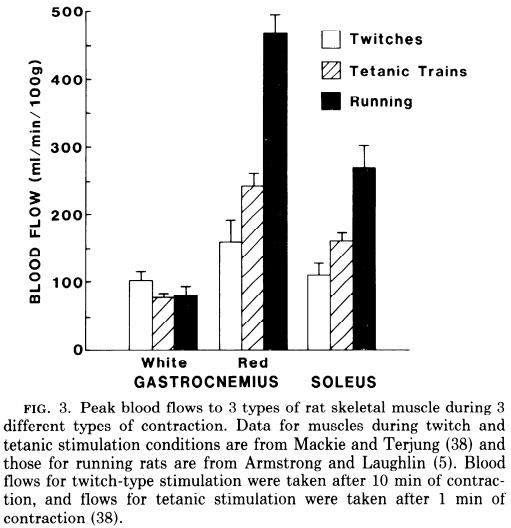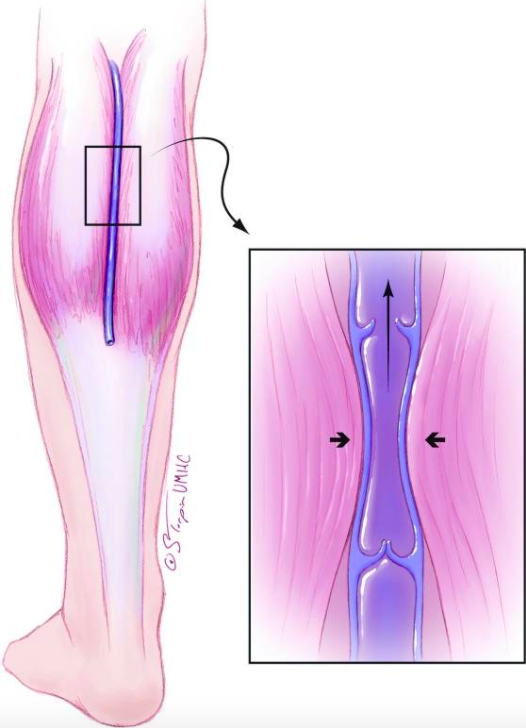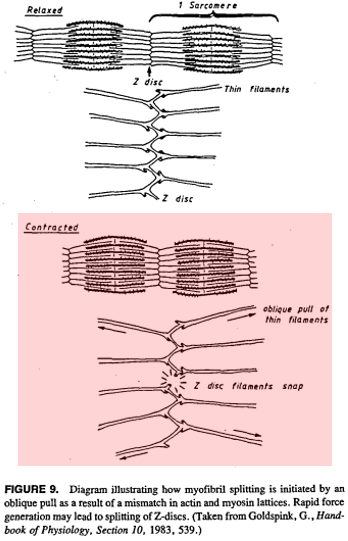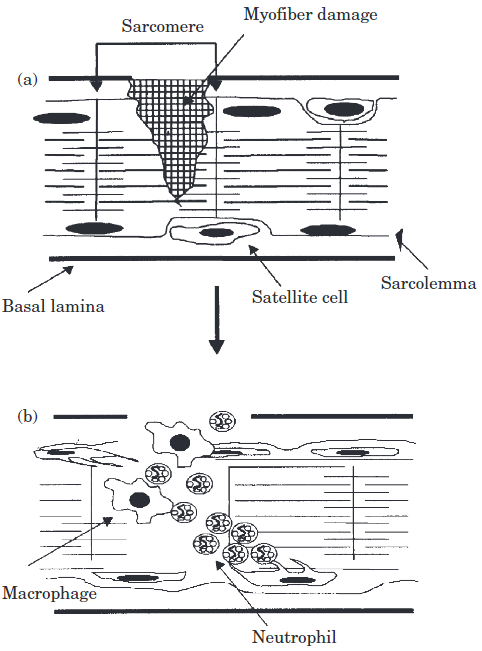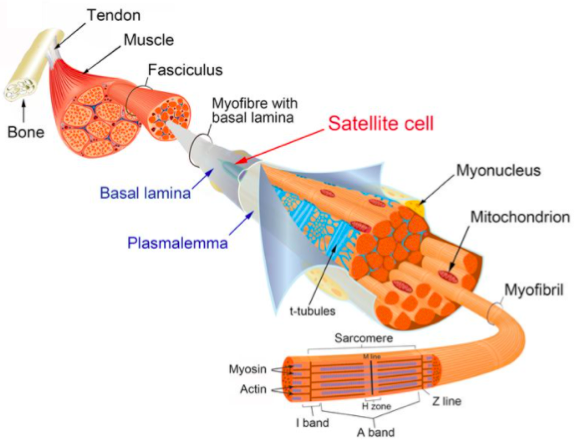1/14
Why do muscles grow in size after weightlifting or other types of resistance training?
The answer is both more straightforward and more complicated than I realized.
Let’s get “swol”...
#Tweetorial #MedTwitter
Why do muscles grow in size after weightlifting or other types of resistance training?
The answer is both more straightforward and more complicated than I realized.
Let’s get “swol”...
#Tweetorial #MedTwitter
2/
First, a review of skeletal muscle physiology:
The fundamental unit of muscular contraction is the sarcomere, made up of actin and myosin proteins.
Myosin slides along actin in an ATP-dependent fashion, shortening the sarcomere, inducing contraction.
https://pubmed.ncbi.nlm.nih.gov/11331913/
First, a review of skeletal muscle physiology:
The fundamental unit of muscular contraction is the sarcomere, made up of actin and myosin proteins.
Myosin slides along actin in an ATP-dependent fashion, shortening the sarcomere, inducing contraction.
https://pubmed.ncbi.nlm.nih.gov/11331913/
3/
Sarcomeres line up in parallel and are bunched into myofibrils.
Myofibrils pack together to make muscle fibers, which comprise skeletal muscle.
https://www.ncbi.nlm.nih.gov/pmc/articles/PMC4193686/
Sarcomeres line up in parallel and are bunched into myofibrils.
Myofibrils pack together to make muscle fibers, which comprise skeletal muscle.
https://www.ncbi.nlm.nih.gov/pmc/articles/PMC4193686/
4/
I assumed the answer to this question was simple - hypertrophy.
But there are 3 phases to muscle growth w/ exercise:
 Muscle pump (immediate swelling)
Muscle pump (immediate swelling)
 Inflammatory (delayed swelling, hours-days)
Inflammatory (delayed swelling, hours-days)
 Hypertrophy (days)
Hypertrophy (days)
Let’s break each one down. https://pubmed.ncbi.nlm.nih.gov/30335577/
I assumed the answer to this question was simple - hypertrophy.
But there are 3 phases to muscle growth w/ exercise:
 Muscle pump (immediate swelling)
Muscle pump (immediate swelling) Inflammatory (delayed swelling, hours-days)
Inflammatory (delayed swelling, hours-days) Hypertrophy (days)
Hypertrophy (days)Let’s break each one down. https://pubmed.ncbi.nlm.nih.gov/30335577/
5/
 First, there is immediate swelling (within minutes of exercise).
First, there is immediate swelling (within minutes of exercise).
 Not surprisingly, blood flow to exercising muscle increases dramatically to meet metabolic demands.
Not surprisingly, blood flow to exercising muscle increases dramatically to meet metabolic demands.
https://pubmed.ncbi.nlm.nih.gov/3318504/
 First, there is immediate swelling (within minutes of exercise).
First, there is immediate swelling (within minutes of exercise). Not surprisingly, blood flow to exercising muscle increases dramatically to meet metabolic demands.
Not surprisingly, blood flow to exercising muscle increases dramatically to meet metabolic demands.https://pubmed.ncbi.nlm.nih.gov/3318504/
6/
Blood flow to muscle during exercise b/c of the so-called muscle pump.
to muscle during exercise b/c of the so-called muscle pump.
Contracted muscle squeezes valved veins, pushing blood through w/ contraction and pulling in more blood w/ relaxation.
 This "pumped" blood flow leads to rapid swelling.
This "pumped" blood flow leads to rapid swelling.
https://www.ncbi.nlm.nih.gov/books/NBK57139/
Blood flow
 to muscle during exercise b/c of the so-called muscle pump.
to muscle during exercise b/c of the so-called muscle pump.Contracted muscle squeezes valved veins, pushing blood through w/ contraction and pulling in more blood w/ relaxation.
 This "pumped" blood flow leads to rapid swelling.
This "pumped" blood flow leads to rapid swelling. https://www.ncbi.nlm.nih.gov/books/NBK57139/
7/
 Next let's look at delayed swelling (hours-days).
Next let's look at delayed swelling (hours-days).
The load from weightlifting causes microdamage to sarcomeres, as actin and myosin are pulled apart w/ forced contraction.
 This is known as myotrauma and is a normal part of resistance training.
This is known as myotrauma and is a normal part of resistance training.
https://pubmed.ncbi.nlm.nih.gov/2222798/
 Next let's look at delayed swelling (hours-days).
Next let's look at delayed swelling (hours-days).The load from weightlifting causes microdamage to sarcomeres, as actin and myosin are pulled apart w/ forced contraction.
 This is known as myotrauma and is a normal part of resistance training.
This is known as myotrauma and is a normal part of resistance training.https://pubmed.ncbi.nlm.nih.gov/2222798/
8/
Myotrauma releases Damage Associated Molecular Patterns (DAMPs).
DAMPs recruit macrophages, neutrophils, and lymphocytes into the recently-exercised muscle.
 Associated prostaglandin release and vasodilation causes delayed muscular swelling.
Associated prostaglandin release and vasodilation causes delayed muscular swelling.
https://pubmed.ncbi.nlm.nih.gov/10805959/
Myotrauma releases Damage Associated Molecular Patterns (DAMPs).
DAMPs recruit macrophages, neutrophils, and lymphocytes into the recently-exercised muscle.
 Associated prostaglandin release and vasodilation causes delayed muscular swelling.
Associated prostaglandin release and vasodilation causes delayed muscular swelling.https://pubmed.ncbi.nlm.nih.gov/10805959/
9/
 The final phase, and source of longterm growth of muscle after weightlifting, is hypertrophy.
The final phase, and source of longterm growth of muscle after weightlifting, is hypertrophy.
 Studies after weight training show an increase in muscle fiber surface area without an increase in the number of fibers, consistent with hypertrophy.
Studies after weight training show an increase in muscle fiber surface area without an increase in the number of fibers, consistent with hypertrophy.
https://pubmed.ncbi.nlm.nih.gov/8941522/
 The final phase, and source of longterm growth of muscle after weightlifting, is hypertrophy.
The final phase, and source of longterm growth of muscle after weightlifting, is hypertrophy. Studies after weight training show an increase in muscle fiber surface area without an increase in the number of fibers, consistent with hypertrophy.
Studies after weight training show an increase in muscle fiber surface area without an increase in the number of fibers, consistent with hypertrophy.https://pubmed.ncbi.nlm.nih.gov/8941522/
10/
Why do muscles hypertrophy after resistance training? It has to do w/ repair of damaged fibers.
We already saw that exercise myotrauma and macrophage recruitment.
myotrauma and macrophage recruitment.
Macrophages also activate a type of muscle stem cell called satellite cells (SC).
https://pubmed.ncbi.nlm.nih.gov/22833472/
Why do muscles hypertrophy after resistance training? It has to do w/ repair of damaged fibers.
We already saw that exercise
 myotrauma and macrophage recruitment.
myotrauma and macrophage recruitment.Macrophages also activate a type of muscle stem cell called satellite cells (SC).
https://pubmed.ncbi.nlm.nih.gov/22833472/
11/
Satellite cells normally reside in a quiescent state in muscle.
 Macrophages secrete IL-6, which recruits and activates them (as do circulating growth factors).
Macrophages secrete IL-6, which recruits and activates them (as do circulating growth factors).
SCs then proliferate and form tube-like structures within the damaged myofibrils.
https://pubmed.ncbi.nlm.nih.gov/10805959/
Satellite cells normally reside in a quiescent state in muscle.
 Macrophages secrete IL-6, which recruits and activates them (as do circulating growth factors).
Macrophages secrete IL-6, which recruits and activates them (as do circulating growth factors).SCs then proliferate and form tube-like structures within the damaged myofibrils.
https://pubmed.ncbi.nlm.nih.gov/10805959/
12/
Satellite cell aggregates secrete actin and myosin, which get incorporated into the damaged myofibrils, repairing and expanding them.
 This leads to hypertrophy and growth of muscle in the days after exercise.
This leads to hypertrophy and growth of muscle in the days after exercise.
https://pubmed.ncbi.nlm.nih.gov/10805959/
Satellite cell aggregates secrete actin and myosin, which get incorporated into the damaged myofibrils, repairing and expanding them.
 This leads to hypertrophy and growth of muscle in the days after exercise.
This leads to hypertrophy and growth of muscle in the days after exercise.https://pubmed.ncbi.nlm.nih.gov/10805959/
13/
In essence, we can distill down the increased size of skeletal muscle after weight training to two factors:
 Increased blood flow (short term)
Increased blood flow (short term)
 Repair of myotrauma (longterm)
Repair of myotrauma (longterm)
In essence, we can distill down the increased size of skeletal muscle after weight training to two factors:
 Increased blood flow (short term)
Increased blood flow (short term)  Repair of myotrauma (longterm)
Repair of myotrauma (longterm)
14/
The next time you workout and your muscles grow, the following events will have occurred:
 Immediate swelling (increased blood flow from the muscle pump)
Immediate swelling (increased blood flow from the muscle pump)
 Delayed swelling (inflammatory response to myotrauma)
Delayed swelling (inflammatory response to myotrauma)
 Hypertrophy (new protein deposition from tissue repair)
Hypertrophy (new protein deposition from tissue repair)
The next time you workout and your muscles grow, the following events will have occurred:
 Immediate swelling (increased blood flow from the muscle pump)
Immediate swelling (increased blood flow from the muscle pump) Delayed swelling (inflammatory response to myotrauma)
Delayed swelling (inflammatory response to myotrauma) Hypertrophy (new protein deposition from tissue repair)
Hypertrophy (new protein deposition from tissue repair)

 Read on Twitter
Read on Twitter
